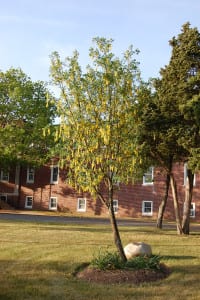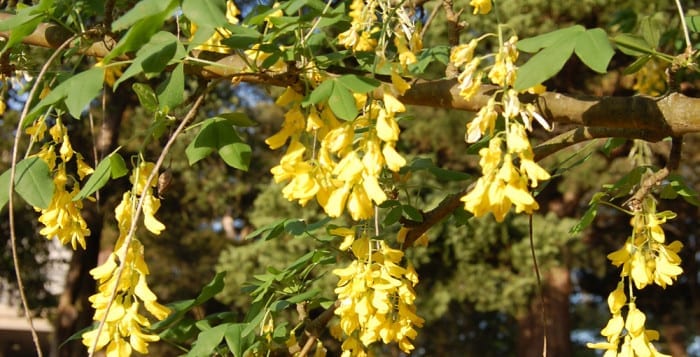Golden chain tree brings sunshine to the garden
By Ellen Barcel
Recently, a reader came across a beautiful tree on the campus of Suffolk County Community College in Selden in late May with absolutely gorgeous yellow flowers. What could it be, she wondered?
After a bit of quick research I was able to identify it as a golden chain tree (Laburnum). A native of the mountains of southern Europe and Asia Minor, it is in the pea family. That, however, does not make it edible as all parts of the plant are poisonous, including the seed pods that follow the flowers in summer. If you decide to go with this plant, put it in an area where young children and pets can’t snack on it.

The pea family is a big one. Most are legumes, that is, are nitrogen-fixing plants. They contain a symbiotic bacteria in their roots that takes nitrogen from the atmosphere for the plant’s use. Other plants in the pea family include the sweet pea, soybeans, edible peas, peanuts, carobs, the black locust tree and kudzu.
The golden chain tree (Laburnum x watereri “Vossii”) blooms in late May and early June for about three weeks with racemes that are about 10 to 20 inches long filled with gold to yellow flowers. Do not confuse the golden chain tree with the golden rain tree (Koelreuteria paniculata), a native of China and India. See my column of April 9 of this year for further information on the golden rain tree.
Some call this small (15 to 20 feet at mature height and about as wide), quick growing, deciduous tree a “Goldilocks plant” since it is very specific in its needs. It does best in hardiness zones 5 to 7. Since it evolved in a mountainous area, it’s logical that it doesn’t like extreme heat. It does best in a soil pH that is near neutral to alkaline. As so much of Long Island has very acidic soil, test your soil first and add lime to the soil if it is substantially below 6.6.
For optimum flowers, plant in a sunny or only slightly shady location. Since you will probably have to add lime to your soil for this one, and it likes sun, growing it as a small specimen tree in a lawn will provide both of these requirements — you probably lime your lawn periodically anyway. It prefers moist but well-drained soil.
The larvae of some Lepidoptera (moths and butterflies) use it as food, a plus for those gardeners wishing to help wildlife. Wear long sleeves and gardening gloves when planting or pruning as some people are allergic to the tree.
Monrovia, one of the suppliers of the golden chain tree, notes that it can be espaliered. This means that it can be pruned into a flat shape to grow against a fence, wall or pergola. If you decide to espalier your tree(s), you might consider interspersing it with vines that bloom later in the season to prolong the bloom time as the flowers last just a few weeks under optimal conditions.
Ellen Barcel is a freelance writer and master gardener. To reach Cornell Cooperative Extension and its Master Gardener program, call 631-727-7850.







